Santo Domingo is the capital of the Dominican Republic. It’s the most populous city in the Dominican Republic and serves as a central hub for the culture, economy, and politics of the Dominican Republic.

Santo Domingo also hosts several cultural events, including music and film festivals, and is home to various cultural institutions like museums, theaters, and art galleries. The city has a vibrant nightlife, diverse cuisine, and a thriving music scene, mainly known for merengue and bachata music.
Where is Santo Domingo?
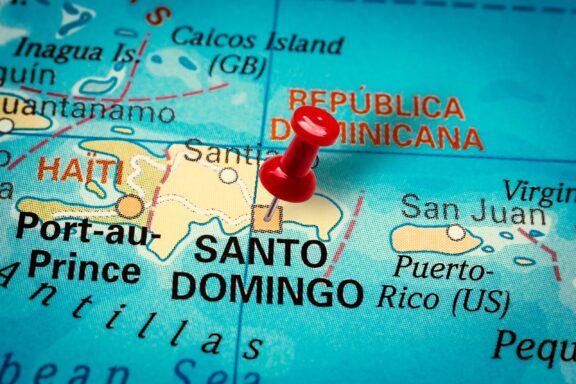
Santo Domingo is located on the southeastern coast of the island of Hispaniola in the Caribbean region. Hispaniola is the second-largest island in the Caribbean and is shared by the Dominican Republic and Haiti.
Santo Domingo lies near the confluence of the Ozama River and the Caribbean Sea. Its geographical coordinates are approximately 18.4861 °N latitude and 69.9312 °W longitude.
Santo Domingo’s position on the southeastern coast has historically made it an important port for trade and a strategic location for maritime travel. Its coastal location also offers beautiful beachfront areas, greatly influencing the city’s culture and lifestyle.
History of Santo Domingo
The history of Santo Domingo begins in 1496, when Bartholomew Columbus, Christopher Columbus’s brother, established the settlement on the east bank of the Ozama River. He named it La Nueva Isabela in honor of Queen Isabella I of Spain. It was soon relocated to the river’s west bank and renamed Santo Domingo in 1498.
During this period, the city saw the construction of many monumental architectural projects, including the Catedral Primada de America, the first cathedral in the Americas; the Alcazar de Colon, the residence of Diego Columbus, Christopher’s son, who became Viceroy of the New World; and the Universidad Santo Tomas de Aquino, the first university in the Americas, founded in 1538.
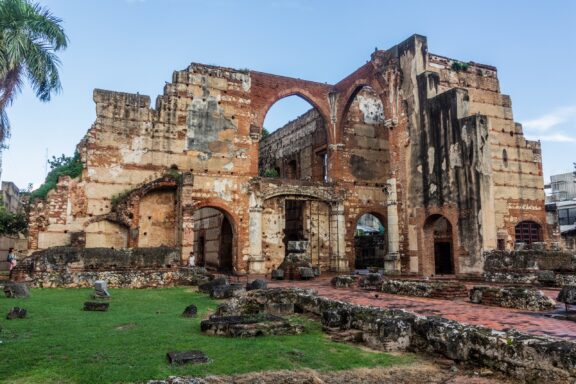
The 16th century was also marked by the slave trade, with enslaved Africans arriving in Santo Domingo from the early 1500s. The city also became an essential hub for the transatlantic trade of goods.
The 17th century was a period of decline for Santo Domingo. By 1606, Spain had abandoned the city due to repeated pirate attacks. The town was primarily left deserted until the early 18th century.
In 1655, an English fleet attacked Santo Domingo but was repelled by Spanish troops and local inhabitants. The city’s heroic defense during this attack helped spark a renewal of Spanish interest in Santo Domingo.
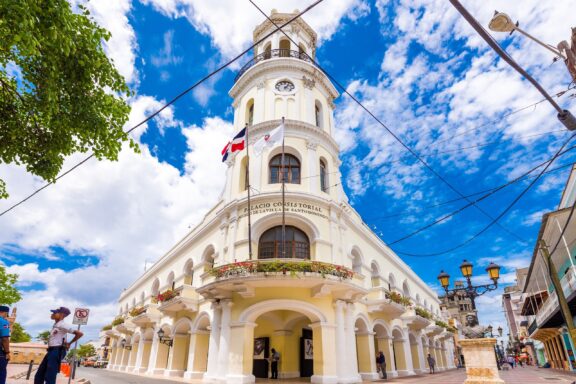
The 18th century brought a series of changes in colonial rule. The 1795 Treaty of Basel transferred the eastern part of Hispaniola from Spanish to French control. The period of French rule was short-lived, as rebellions, disease, and economic difficulties plagued the colony.
In 1844, the Dominican Republic declared its independence from Haiti. Santo Domingo became the capital of the new republic. Numerous changes in government, civil wars, and political instability marked the rest of the 19th century.
The 20th century brought significant transformation for Santo Domingo. The dictatorship of Rafael Trujillo, which lasted from 1930 to 1961, was a defining period. Trujillo oversaw significant modernization efforts despite his oppressive regime, including infrastructure development.
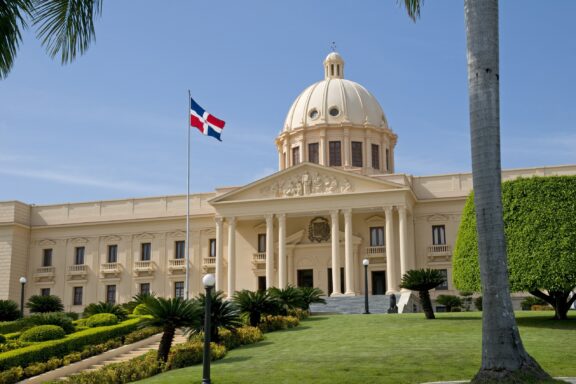
Following Trujillo’s assassination in 1961, the city experienced a period of political and social unrest, culminating in a civil war in 1965. The conflict ended with a U.S. military intervention.
The modern city boasts a blend of historical charm and contemporary amenities. The city has developed into the country’s political, economic, and cultural centre. Today, Santo Domingo remains a vivid testimony to the history of the New World, the city’s past always visible despite the bustling rhythm of a modern city.
Features of Santo Domingo
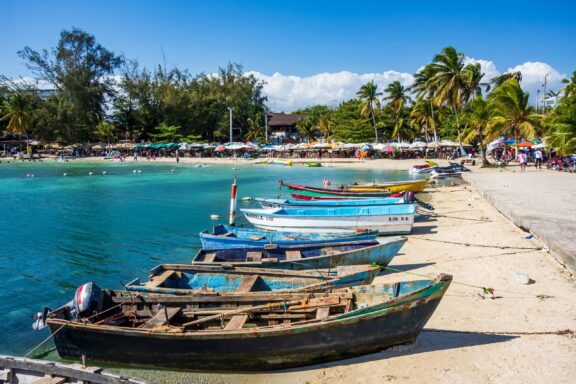
Santo Domingo is a city of contrasts where the old and the new converge harmoniously. Santo Domingo’s historical significance is within its modern, cosmopolitan energy. The city’s more pristine areas are characterized by bustling streets, modern architecture, and commercial zones that starkly contrast with the Colonial Zone’s tranquillity.
Geography and Climate
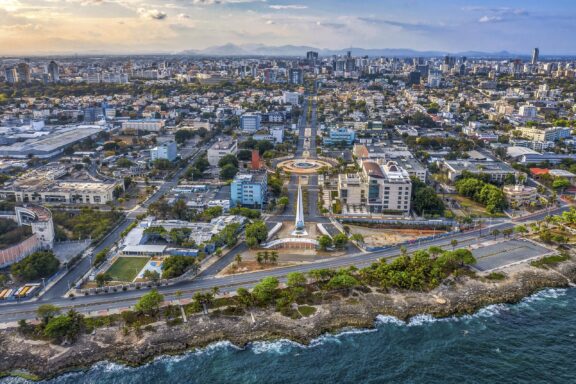
Santo Domingo is characterized by a relatively flat terrain interspersed with minor hills. The Ozama River, which bisects the city, is a significant geographical feature, forming a natural boundary that separates the city’s east and west regions.
As for its climate, Santo Domingo experiences a tropical monsoon climate. There are only minor variations in temperature throughout the year, with average highs ranging from 28 to 31 degrees Celsius (82-88 °F) and average lows from 20 to 24 °C (68-75 °F). The city experiences a dry season from December through March and a rainy season from May to November. Hurricanes can occur between June and November.
Population
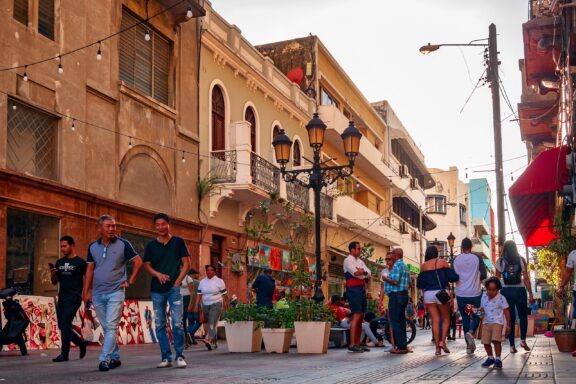
Santo Domingo has a population of over 2.5 million people. It’s the most populated city in the Caribbean region. The population of Santo Domingo is diverse, reflecting the city’s rich history. The majority are of mixed African, European, and indigenous Taíno descent. Spanish is the official and most widely spoken language in the city.
Santo Domingo is known for its vibrant culture and the warmth of its people. The city’s residents, known as ‘quisqueyanos,’ are noted for their hospitality, and their cultural life is marked by a love for music, dance, sports, and various local festivals.
Economy
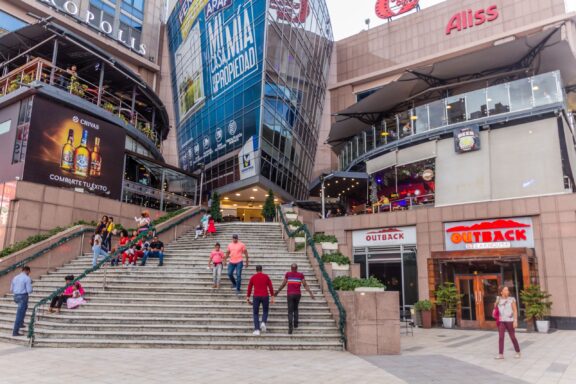
Santo Domingo plays a central role in the Dominican Republic’s economy. It’s a significant center for the country’s growing service sector, which includes telecommunications, finance, real estate, and tourism. The city hosts the headquarters of many of the country’s largest corporations and the Santo Domingo Stock Exchange. It also has several industrial zones where consumer and industrial goods are produced.
Tourism is a crucial industry in Santo Domingo, attracting visitors with its historical sites, particularly in the Colonial Zone, cultural festivals, and beautiful beaches. The city’s rich history, vibrant culture, and warm climate make it a popular destination for both domestic and international tourism.
In addition, Santo Domingo has one of the most advanced telecommunications infrastructures in the region, making it a prime location for call centers and other IT industries.
The city’s port, the Port of Haina, is the busiest in the country and plays a crucial role in domestic and international trade. The port and the city’s bustling La Isabela International Airport and Las Américas International Airport make Santo Domingo a vital regional transportation and logistics heart.
Things to Do and Places to See in Santo Domingo
Santo Domingo presents an array of engaging activities and intriguing sights to explore. Let’s delve into some of this captivating city’s most sought-after destinations and attractions.
1. Ciudad Colonial
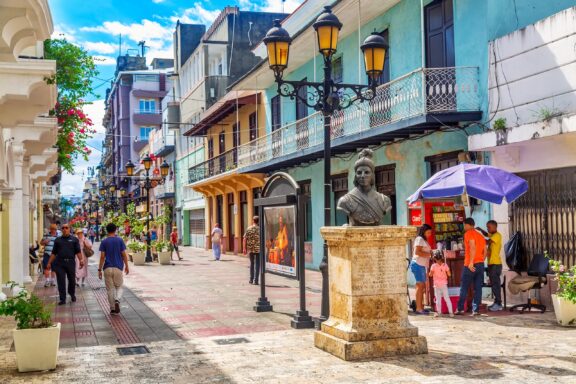
The Ciudad Colonial, also known as Zona Colonial or Colonial Zone, is the historic central neighborhood of Santo Domingo and the oldest permanent European settlement in the Americas. It was declared a UNESCO World Heritage Site in 1990.
The Ciudad Colonial is characterized by many 16th-century structures, including palaces, houses, churches, and fortresses, which reflect the architectural style of the late medieval period. Exploring the Colonial Zone offers a window into the past, and a deep understanding of the significant history of Santo Domingo, Dominican Republic.
2. Catedral Primada de America
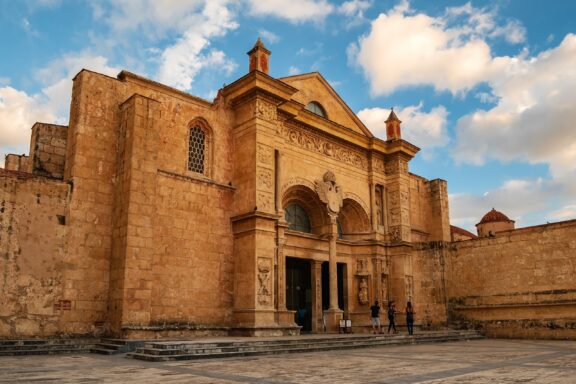
The Catedral Primada de America, also known as the Cathedral of Santa Maria la Menor, is a striking landmark in Santo Domingo. It holds the distinction of being the oldest cathedral in the Americas, symbolizing the long and rich history of the city.
The cathedral’s construction began in 1512 under the direction of Diego Columbus, Christopher Columbus’s son, and was consecrated in 1541. The cathedral blends different architectural styles, with Gothic and Baroque influences most apparent, showcasing the creativity and craftsmanship of the period.
3. Alcázar de Colón
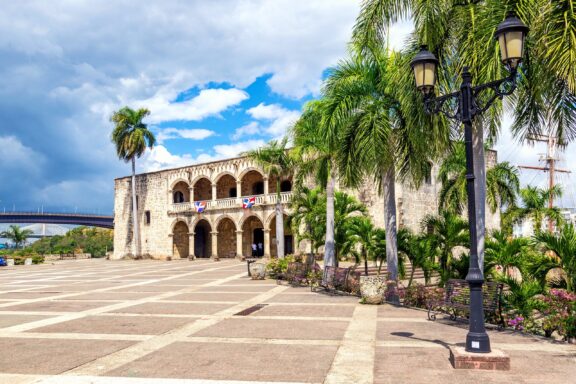
The Alcázar was the center of the Spanish court for many years, playing a significant role in the administration of the colonies in the New World. Decisions affecting the fate of the burgeoning Spanish Empire in the Americas were made from these halls.
Built in the early 16th century, the Alcázar de Colón was the home of Diego Columbus, Christopher Columbus’s son, who served as the Viceroy of the Indies. This imposing edifice in the Zona Colonial of Santo Domingo reflects Spanish colonial architecture with its Gothic and Renaissance influences.
4. Museo de las Casas Reales
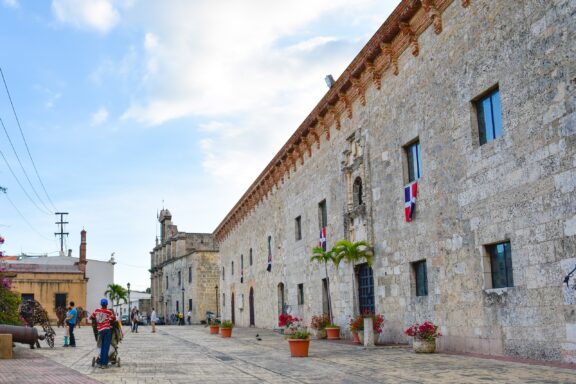
The Museo de las Casas Reales, or Museum of the Royal Houses, is an essential stop for anyone visiting Santo Domingo. Housed in a beautifully restored building that dates back to the 16th century, the museum offers a rich overview of the history and culture of the Dominican Republic and the broader Caribbean region.
Originally constructed to house the administrative offices of the Spanish colonies in the Americas, the building served as the home of the Royal Court, the first court of law in the New World, and later as the residence of the Governors and General Captains of the colony.
5. Parque Colon
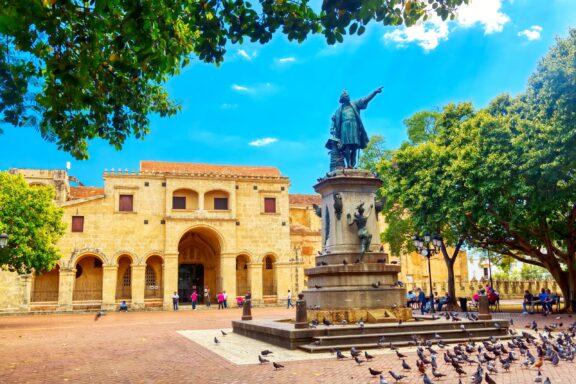
Parque Colon, or Columbus Park, is a vibrant and bustling square in the heart of Santo Domingo’s Zona Colonial. Named after Christopher Columbus (Cristóbal Colón in Spanish), the park is a popular gathering place for locals and tourists, offering a perfect spot for relaxation, people-watching, and soaking in the city’s lively atmosphere.
Surrounding the park are a variety of architectural and historical points of interest. On one side of the square is the stunning Catedral Primada de America, the oldest cathedral in the Americas. The park’s peripheral streets have beautifully preserved colonial-era buildings, housing restaurants, cafes, shops, and art galleries.
6. Fortaleza Ozama
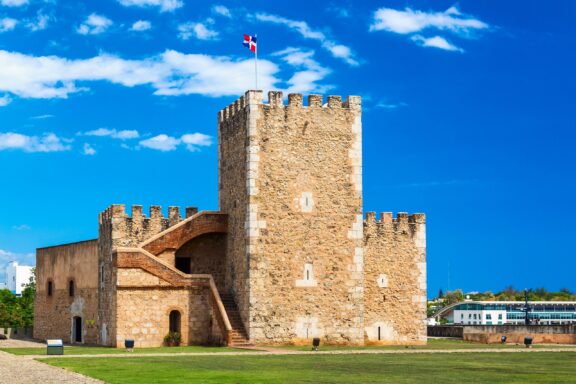
Fortaleza Ozama, or Ozama Fortress, is a significant historical landmark in Santo Domingo, marking the city’s rich colonial past. Constructed between 1502 and 1508 under the governance of Frey Nicolás de Ovando, it is considered the oldest formal military construction of European origin in the Americas.
The fortress was built strategically on the eastern bank of the Ozama River, meant to guard the entrance to the Santo Domingo Harbor. Its key position enabled control over all maritime access to the city, providing a critical defense against pirate attacks and other threats during the colonial era.
7. Malecón
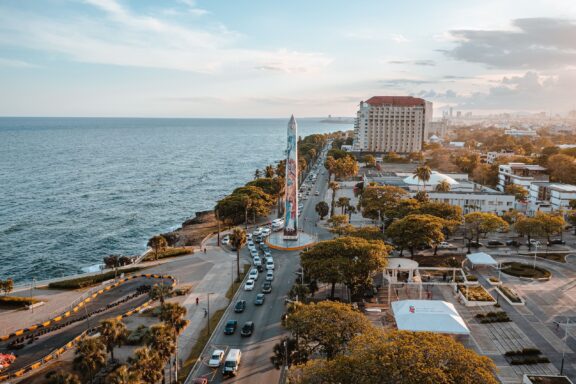
The Malecón is a social, cultural, and entertainment corner that offers stunning ocean views and an authentic taste of local Dominican life.
The boulevard has numerous restaurants, cafes, nightclubs, and hotels, including some of the city’s most luxurious accommodations. In the evening, the Malecón comes alive with music and dance as locals and visitors enjoy merengue, salsa, and bachata rhythms, often played live.
The Malecón also hosts several important monuments and landmarks. The towering Obelisk, for instance, serves as a frequent gathering spot for cultural events. Another eye-catching monument is the Statue of Fray Antón de Montesinos, a friar who was one of the first to publicly denounce the mistreatment of indigenous peoples by the Spanish colonists.
8. Jardin Botanico Nacional
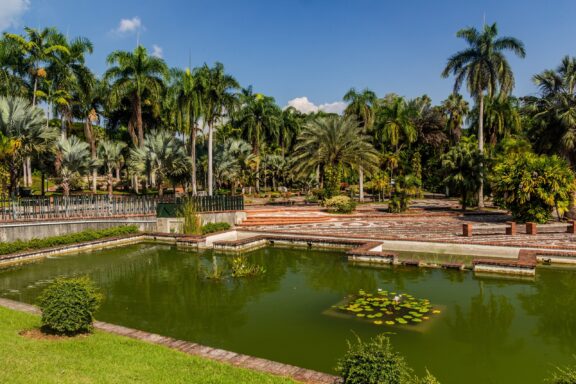
The Jardín Botánico Nacional, or National Botanical Garden, is an oasis of green in the heart of Santo Domingo. One of the garden’s highlights is the Japanese Garden, a beautifully designed landscape with a pond, a teahouse, and a range of Japanese plant species. It’s a popular spot for relaxation and reflection.
Established in 1976 and named after Dr. Rafael M. Moscoso, a noted Dominican botanist, the garden is home to various plant species, both endemic and worldwide. Visitors can explore diverse sections dedicated to ferns, orchids, medicinal plants, palms, and more. The garden is renowned for its collection of over 300 species of orchids.
9. Ágora Mall
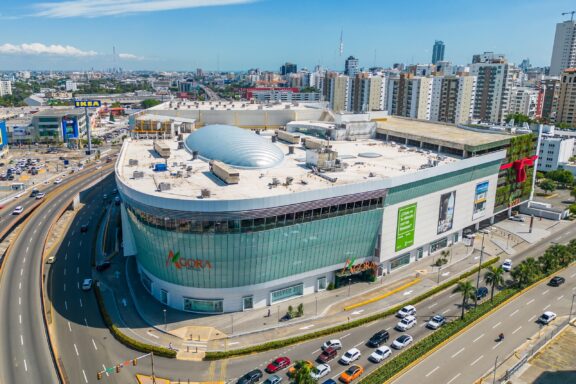
Ágora Mall is one of the premier shopping destinations in the heart of Santo Domingo. It’s a modern, multi-level complex that offers various retail stores, dining options, and entertainment facilities, making it a popular spot for locals and tourists.
The mall features a vast selection of international and local brands spanning categories such as fashion, electronics, beauty, home decor, and more. Whether you’re searching for the latest trends and unique souvenirs or want to enjoy window shopping, Ágora Mall provides a diverse shopping experience to suit all tastes.
10. Monasterio de San Francisco
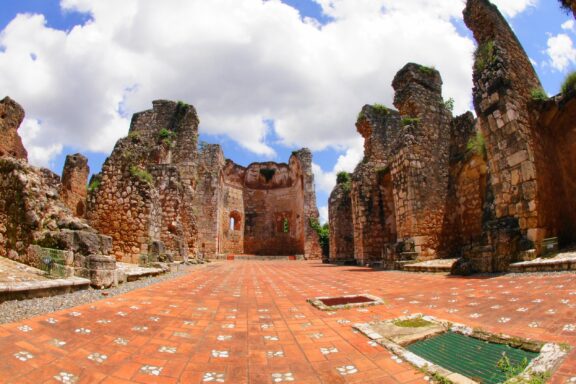
The Monasterio de San Francisco, or the Monastery of San Francisco, is one of Santo Domingo’s most iconic historical landmarks. Located in the heart of the city’s Colonial Zone, this ancient monastery is known for its historical significance and stunning architecture.
It was constructed under the patronage of Franciscan friars and was once a grand structure with a church, a monastery, and a convent. The site was the home of the first university in the New World, the Universidad Santo Tomás de Aquino, founded in 1538.
Over the centuries, natural disasters, including hurricanes and earthquakes, damaged the Monasterio de San Francisco several times. It was rebuilt on numerous occasions, but parts of it were eventually abandoned and fell into ruins.
11. Los Tres Ojos
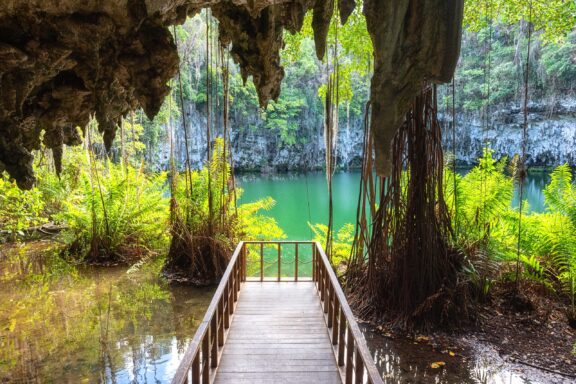
Los Tres Ojos, or “The Three Eyes” in English, is a natural wonder in the eastern part of Santo Domingo. It’s a series of three limestone sinkhole lakes, or cenotes, connected by a series of stunning caverns.
Each “eye” represents a distinct lake with unique characteristics. The first lake, “Lago de las Damas” or “Ladies’ Lake,” is the largest and most profound. The second lake, “Lago de los Sulfuros” or “Sulphur Lake,” is known for its sulfurous waters, believed by some to have therapeutic properties. The third lake, “Lago de las Aguilas” or “Eagles’ Lake,” is so named because eagles often visit it.
Final Thoughts
Santo Domingo, the oldest city in the New World, offers a unique blend of historic charm and modern vibrancy. It provides a wide range of experiences for all types of travelers. The city offers plenty, from its stunning architecture and historical sites to its diverse cuisine, bustling markets, and vibrant nightlife.
The warm hospitality of its residents further enhances the visitor experience. So, whether you’re a history buff, a food lover, a culture enthusiast, or simply looking to unwind, Santo Domingo is worth a visit. It’s a city where the past and present merge seamlessly, promising an unforgettable journey for anyone exploring its charming streets.
Image Sources and Copyright Information
- Map Pinpointing Santo Domingo in the Dominican Republic: © andriano.cz/Shutterstock
- Ruins of Hospital San Nicolas de Bari: © Matyas Rehak/Shutterstock
- Colonial City Hall Building under Blue Sky: © gg-foto/Shutterstock
- National Palace in Santo Domingo: © Gary Blakeley/Shutterstock
- Boats on the Shore at Boca Chica Beach, Santo Domingo: © Giongi63/Shutterstock
- Aerial View of Santo Domingo Coastline and Cityscape: © Wirestock Creators/Shutterstock
- Picturesque Street Scene with Pedestrians: © saaton/Shutterstock
- Stairs Leading to Urban Shopping Center: © Matyas Rehak/Shutterstock
- Bustling Street in Santo Domingo’s Colonial Zone: © Nick N A/Shutterstock
- Catedral Primada de America Exterior View: © saaton/Shutterstock
- Alcazar de Colon and Plaza: © Nick N A/Shutterstock
- Historic Building Facade with Pedestrians: © GiuseppeCrimeni/Shutterstock
- Statue in a Sunny Plaza with Historical Building: © Nick N A/Shutterstock
- Fortaleza Ozama under blue sky: © Wirestock Creators/Shutterstock
- Coastal Road and Promenade at Sunset: © Wirestock Creators/Shutterstock
- Tropical Botanical Garden with Pond: © Matyas Rehak/Shutterstock
- Aerial View of Modern Shopping Mall in Urban Setting: © onapalmtree/Shutterstock
- Ruins of the Monasterio de San Francisco: © LighthunterWS/Shutterstock
- Tropical Limestone Cave with Emerald Pool and Wooden Walkway: © Uhryn Larysa/Shutterstock